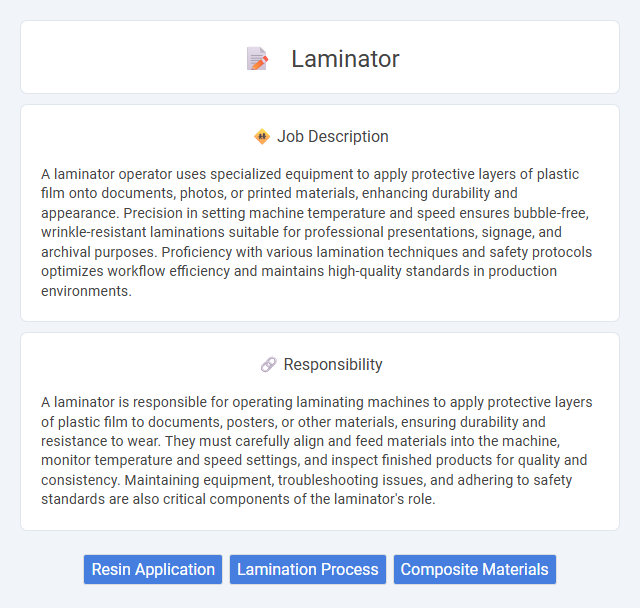
A laminator operator uses specialized equipment to apply protective layers of plastic film onto documents, photos, or printed materials, enhancing durability and appearance. Precision in setting machine temperature and speed ensures bubble-free, wrinkle-resistant laminations suitable for professional presentations, signage, and archival purposes. Proficiency with various lamination techniques and safety protocols optimizes workflow efficiency and maintains high-quality standards in production environments.
Individuals with good hand-eye coordination and attention to detail are likely to be suitable for a laminator job, as the role often requires precise handling of materials. Those who prefer repetitive tasks and can maintain focus in a controlled environment may find this position fitting. However, people with limited dexterity or difficulty standing for extended periods might find the job challenging.
Qualification
A laminator operator must possess technical skills in handling various laminating machines and materials, ensuring precision and consistency in film application. Proficiency in machine setup, routine maintenance, and troubleshooting is essential to maintain production efficiency and product quality. Attention to detail, manual dexterity, and knowledge of safety protocols are critical qualifications for success in laminator roles.
Responsibility
A laminator is responsible for operating laminating machines to apply protective layers of plastic film to documents, posters, or other materials, ensuring durability and resistance to wear. They must carefully align and feed materials into the machine, monitor temperature and speed settings, and inspect finished products for quality and consistency. Maintaining equipment, troubleshooting issues, and adhering to safety standards are also critical components of the laminator's role.
Benefit
Using a laminator likely enhances document durability by protecting papers from spills, tears, and fading, making it a valuable tool for preserving important materials. It probably improves presentation quality through a glossy, professional finish, which can boost perceived value in educational or business settings. The convenience of quick sealing may increase efficiency in handling frequent lamination tasks, saving time in workflows.
Challenge
The laminator job likely involves challenges such as managing precise temperature and pressure settings to avoid damaging materials. There is a probability of encountering issues with alignment and air bubbles during the lamination process that require careful attention. Troubleshooting machine malfunctions and maintaining consistent quality output may also present ongoing difficulties.
Career Advancement
Laminator operators can advance their careers by gaining expertise in advanced laminating technologies, quality control, and machine maintenance. Developing skills in materials science and production management paves the way for supervisory or technical specialist roles. Continuous training and certifications enhance opportunities for leadership positions within manufacturing and printing industries.
Key Terms
Resin Application
A laminator specializing in resin application expertly spreads resin onto various substrates to ensure strong adhesion and durability. Precise control of resin viscosity and curing time is critical to achieve a uniform, bubble-free coating that enhances product strength. Mastery in different resin types such as epoxy, polyester, and vinyl ester allows for tailored applications across automotive, aerospace, and construction industries.
Lamination Process
The lamination process involves applying a protective layer, typically a plastic film, to materials like paper, fabric, or photographs to enhance durability, water resistance, and appearance. This process uses heat, pressure, or adhesive to bond the laminating material firmly to the substrate, ensuring a smooth and wrinkle-free finish. Lamination increases product longevity by safeguarding against wear, tear, moisture, and UV damage, making it essential in industries such as printing, packaging, and signage.
Composite Materials
A laminator specializing in composite materials expertly layers fibers and resin to create lightweight, high-strength components used in aerospace, automotive, and marine industries. Precision in temperature, pressure, and curing time ensures optimal bonding and structural integrity of carbon fiber, fiberglass, and other advanced composites. Mastery of vacuum bagging and autoclave techniques enhances the durability and performance of composite laminates critical for cutting-edge engineering applications.
 kuljobs.com
kuljobs.com